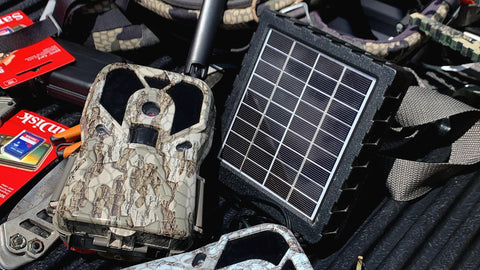The Best Batteries For Cellular Trail Cameras
With the shift towards cellular trail cameras, users are quickly finding out connected devices consume more power than regular sd card cameras. Over the last 20 years trail camera users have grown accustomed to power consumption characteristics of standard trail cameras. Now all of a sudden, those same trail camera users are rushing into cellular trail cameras with the same expectations. The experience is eye opening for many.
Let's take a look at why cellular trail cameras use more power, what batteries are the best for cell cameras, and how you can get at least a season out of your trail camera setup.
Frame of Reference - Why Cell Cams Consume More Power
Imagine having your cell phone ran off a set of AA batteries....You wouldn't expect much more than a couple of days use right? Yet in the trail camera world, we expect connected devices to last months and months. I'm not saying cellular trail cameras are as powerful as your mobile phone, but they still have to connect to a cellular network and transmit data. This is capable with added cellular hardware...things like a cellular module, patch antennas, external antennas, and required circuitry.
When we talk about adding cellular modules to trail cameras this is where the increase of power consumption comes from. Cellular trail cameras need to connect to a cellular network, when programmed, to transmit photos and videos. Cellular trail cameras also need to be able to receive and execute commands like setting changes, FW updates, and other requests over the air. All of this is only capable with added cellular hardware. These abilities that trail camera users find useful all lead to increased power consumption.
Internal Batteries and Capacity
From an engineering standpoint, manufacturers know and understand the rigorous power needs of cellular trail cameras. This is why often times you will see manufacturers only recommending lithium batteries for internal use, much like other recommendations for high power consumption devices. Lithium batteries offer constant voltage output until their capacity is completely used up. In addition to better voltage output, lithiums also carry better capacity over alkalines and NiMh batteries.
While some cameras run on multiple parallel and series designs, not all do. The advantage of multiple parallel and series battery designs is users can essentially run multiple sets of batteries at once. The downside is that the overall camera design is much larger to accommodate. The exact opposite is true for 1P1S designs...The cameras are typically smaller in size but are limited to one set of batteries. Either way this point is kind of mute but worth noting.
External Power Sources Are King

The biggest advantage of cellular trail cameras is not having to check and pull cards. This is two fold in reality. First, it saves trail camera users time...which in my opinion is the biggest advantage. Secondly, cellular trail cameras limit human intrusion which is ultra critical on any hunting parcel. So with the point and objective of cellular trail cameras being set it once, let it do the work, and "forget" about it, having enough power becomes the key contingency.
While external power sources do add cost to the cellular trail camera, users cannot experience the full benefit of connected trail cameras without it. The beautiful thing with external power sources is that most are rechargeable so the cost is only realized once. For instance, I personally have had an Exodus Render in the field running for over 3 years with internal batteries and an SP18. A combo like this provides 3Ah of internal capacity and 3Ah of rechargeable external capacity. When you think about the cost of running a cellular trail camera non stop for 3 years only on internal batteries, it becomes very easy to justify the cost of an external power source.
Pro tips
Lithiums cells for Internal Power - There's more info around Lithium AA batteries here.
Limit live or On Demand functions to save on power - Understand and know your cell camera settings and functions.
Prolong upload intervals to help save power - Because the cell camera's module is the biggest difference in power consumption, limiting how many times it needs to connect will extend the battery life.
Run internal batteries in conjunctions with external power sources - The internals will operate as "backup" in case of the external source failing or coming unplugged.
Author: Chad Sylvester, Exodus Co-Founder/Owner





